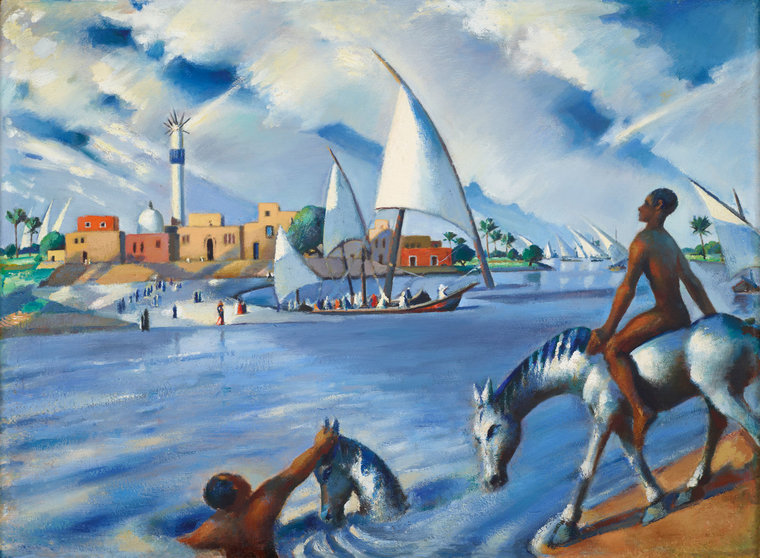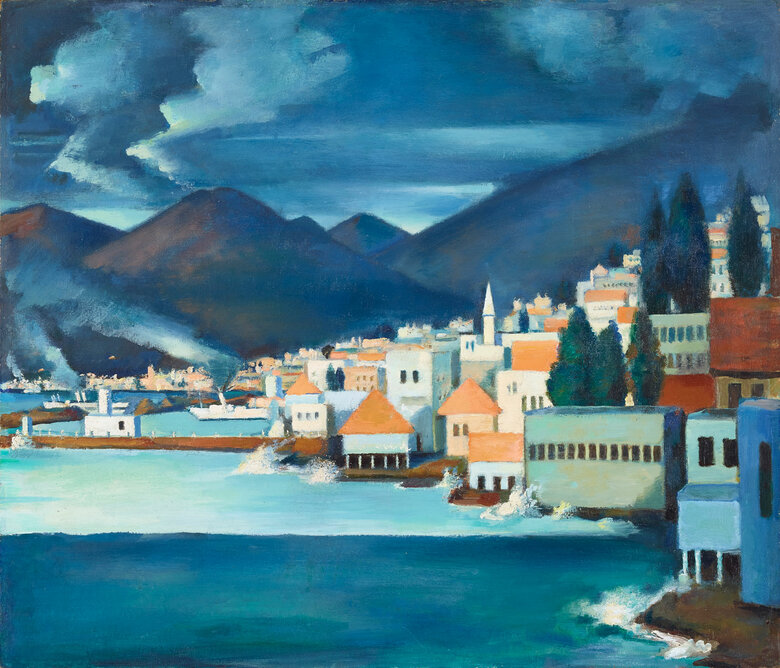Bain des Chevaux à Rosette, 1950, by Alexandrian artist Mahmoud Said depicts an idyllic representation of the Rosetta port city by the Nile, with two nude, strong men and their horses along the bank: one man is regally riding his horse as the other wades into the river with his. The vibrant blues and white of the water, sky, clouds, horses, sail, and mosque dominate the color palate of this composition, allowing the other colors, specifically the brown skin tone of the riders, to be emphasized.
This painting is the most representative of Said’s oeuvre and the themes he had explored throughout his prolific artistic journey. In it, he presents a utopian vision of daily life, where social and economic inequalities no longer exist 1. The purpose is not solely a critique of the social conditions that the underprivileged mass is subject to: for instance, this painting does not portray the fellahin toiling away at their land. Rather, they are depicted nude, riding horses without saddles, and seemingly more in touch with nature as they guide their animals across the Nile to join those on the other side. In contrast, the people along the banks are clothed, there is a mosque and dahabeah 2 at the harbor and all along the river. In the 19th century, dahabeahs were used to transport tourists, particularly Westerners and aristocrats who might enjoy such an ‘adventure’ 3. By foregrounding the underprivileged nonchalantly making their way across the river to join the elites on the other side, Said is bringing together the different classes into a picturesque and harmonious coexistence.
Through an amalgamation of varying styles, Said brings out the sense of changelessness and continuity between ancient Egypt and its modern turn 4 . Said had studied the frescos and ancient reliefs at the Tombs of the Nobles 5 during his exploration of Aswan and Luxor 6. He had also been inspired by the Italian Primitives 7 , which he had been exposed to during his time in Italy, Rome, and Florence 8. Said would most noticeably draw upon the Amarna style developed during the time of the Pharaoh Akhenaton. This is significant because Akhenaton’s relatively short reign represents a significant break from past dynasties in relation to political, theological, and artistic styles 9. Similarly, for many artists of Said’s period, aka the first generation, the cultural shifts occurring in Egypt at the time paralleled the seismic changes of Akhenaton’s rule: they too looked to embrace Egypt’s pharaonic past as a means of claiming a nationalistic identity. Within this work, the elements that Said drew upon in particular was the elongation of the head, a style that is unique to the Amarna artworks 10. Thus, Said is imbuing his fellaheen with the nobility of the Pharaohs.
Said is considered one the most prominent artists of his era, and his work exemplified the move away from the Western orientalist style of painting of those that came before him. As a member of the art group that came to be known as the Pioneers 11, al-ruwwad, whose works attempted to adhere or reflect an Egyptian culture that could simultaneously be national and universal 12. Although belonging to the upper class of Egyptian aristocracy, Said’s experience as Judge from 1927-1947 had exposed him to people from various classes of Egyptian society 13. He would often ride along the coast, where he could see the peasants at work 14. Indeed, his choice to depict the underprivileged class at all was considered borderline social and class treason 15 – more so, since the subjects of his paintings are shown as inherently dignified in the magical and utopian worlds created by Said 16. To that end, Said’s legacy is his elevation of the ordinary and often invisible people into full personhood through his commitment to an Egypt devoid of social inequality 17 .
Notes:
1 Kanafani, Fatenn Mostafa. "Made in the Arab World." Rawi, Issue 8 (2016). https://rawi-publishing.com
2 Dahabeahs or feluccas are traditional Mediterranean wooden sail boats. In Egypt, they were often used to transport goods along the Nile River.
3 Contemporary travel agencies selling dahabeah tours often include in their promotional material the luxurious aspect of feeling like the aristocrats or part of the elite of the monarchy period.
4 Radwan, Nadia. "Between Diana and Isis: Egypt’s “Renaissance” and the Neo-Pharaonic Style (1920s‒1930s)." Dialogues artistiques avec les passés de l'Égypte: une perspective transnationale et transmédiale, Paris, InVisu (CNRS-INHA)(«Actes de colloques») (2017). Accessed October 3, 2023. https://books.openedition.org
5 These are tombs of ancient Egyptian princes, workers, priests, officials, soldiers, etc.
6 Radwan, “Between Diana and Isis”.
7 Italian paintings from the 13th century to the 15th century.
8 Radwan, “Between Diana and Isis”.
9 Radwan, “Between Diana and Isis”. “Akhenaton embodied a rupture with the preceding dynasties on several levels: firstly, political, with the establishment of the new capital of Akhetaton; then theological, with the instauration of the cult of a unique god, Aton; and, more importantly, artistic, with the birth of a distinct ‘Amarnian style,’” 28
10 Kanafani, Fatenn Mostafa. Modern Art in Egypt: Identity and Independence, 1850–1936. Bloomsbury Publishing, 2020.
11 This included Naghi, Moukhtar, and Ayad
12 Radwan, “Between Diana and Isis”
13 Radwan, “Between Diana and Isis”
14 Debsi, Arthur. "Imagery of the Egyptian Peasant 1911-1956." Dalloul Art Foundation, 2022. https://dafbeirut.org
15 Kanafani, Modern Art in Egypt. Kanafani notes how his art had “scandalized his elitist milieu” p. 193
16 Kanafani, Modern Art in Egypt
17 Kanafani, Modern Art in Egypt



-Front.jpg)
-Front.jpg)





